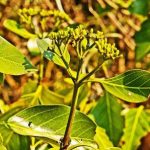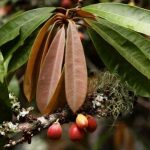TREE LIFE
DECEMBER 1991
MASHONALAND CALENDAR
Tuesday 3rd December : Botanic Garden walk at 4.45 For 5 p.m. Park at the Herbariun where we will meet Tom Muller.
Sunday 22nd December : Our Christmas social this year will be at Ewanrigg Botanical Gardens. There is a shelter if it rains, so bring a Christmas picnic lunch and enjoy the day amongst the aloes and everything else that Ewanrigg has to offer. Kim is cooking up an amusement! Please remember to bring some filthy lucre. Ewanrigg is a National Park and there is an entrance fee. We meet at the main car park where the plan of action will be decided once we know what sort of weather to expect.
Wednesday 25th December : The Chairman and Committee members wish you and your extended families a joyful and peaceful Christmas, and may your dreams come true in 1992.
Tuesday 7th January : Botanic Garden walk.
Sunday 19th January : Tsindi Ruins, Theydon, near Marondera
Saturday 25th January : walk with Mark
MATABELELAND CALENDAR
Sunday, 1st December 1991 : To Mguza Nature Reserve, 15 km out on the Victoria Falls Road. We haven’t been there for some time and there has been quite a bit of development done. The study centre (with a beautiful view of the dam) is finished,a couple of summer houses built, and a hide and pan servicing the many animals introduced into the park – all very exciting. Entrance Pee is $1 each – morning only – bring tea time and chairs. Meet once again at Falls Road Motors at 8.30 am.
Wednesday, 18th December 1991 : the last McHEW of the year – exams are finished, you can come back now! 5.00 pm at Hillside Dams. –
Wednesday, 1st January, 1992 : Most of you have been signed up already by Angie for the New Years Party at the Blakes – roll up from ll.30 am – and just see what happens: Please bring chairs – umbrellas (sun or rain) and of course all those eating and drinking goodies a la Angie: Phone 61384 (work) or 62229 (home) for directions – see you there:
Sunday, 5th January 1992 : Just to see if you have recovered from the previous Wednesday, we will spend the morning at Mabukuwene, Chipping Way, Burnside. There are several parts we still haven’t visited and it should not be too strenuous! Bring tea-time and chairs and meet there at 8.30 am.
Wednesday, 15th January 1992 : Hopefully, if we give Ian some leaves, he will continue the exciting McHEWs in the new year – 5 pm at Hillside Dams.
Sunday, 2nd February 1992 : Depending on the weather we will have another try at getting more members to the very exciting and attractive Lumana Falls, tree fern grove and the orbicular granite (Diana’s Pool) on the eastern side of Matopos. A full day including our branch AGM.
THETFORD ESTATES – 20TH OCTOBER 1991
There’s a lot to be said for an old fashioned typewriter. I had just finished my masterpiece to find that the computer had not saved my work. So here goes again, this time without the flowery prose.
One cannot but be impressed by the sight of Thetford House as you suddenly see it after driving up and up a steep windy road on the estate. When I arrived most of the members were out on the verandah having tea with our hosts Jacqui and Dave Narracott, and no doubt enjoying the wonderful view over the Mazowe hills to the lake beyond.
We walked through the gardens to the main gate, on the lawn is a lovely Pterocarpus angolensis – mukwa, mu-vambaropa(sh), nfagezai(nd) – for those who like to know the local names. The names aptly describe it as the bloodwood, because of the red sap which oozes out when cut. A lightening scar at the root reminded George of the story of the lightening bird who is reputed to lay its eggs wherever lightening strikes.
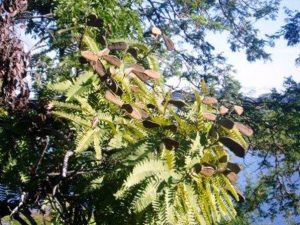
Brachyategia bohemii. Photo: Mark Hyde. Source: Flora of Zimbabwe
At the gate, there is a good sized Brachyategia bohemii, with its noticeable overlapping leaflets, like ostrich feathers, – the prince-of-wales feathers, locally called the mfuti. It makes good gudza mats, I believe. Its flowers have insignificant small petals, but possess nectaries. Kim feels that dominant tree species, which form a canopy, did not need to develop colourful petalous flowers to attract insects, rather utilizing heavily scented nectaries instead. Did I get it right, Kim?
Outside the gate, on a rocky outcrop there is a small Stereospermun kanthianum, the pink jacaranda, not in flower. Nearby was a Lannea discolor the live-long tree, which strikes easily. A Tricalysia was in full flower a lovely show of white. There was also a Strychnos innocca although the leaves were not entire, but minutely crenate. There was Elephantorrhiza goatzei, larger than usual, and a Sterculia quinqueloba, although the bark suggested africana.
We came across a beautiful Erythrina, the size of the pods, being very large indicated that it was E.latissima. Also the rocky site was typical of the species. However the bark was not corky. A Terminalia seen possessing moon craters (help!, where?) suggested T.stanostachia. I’m afraid the readers will have to look it up. (Leaf soars 7 – Ed.)
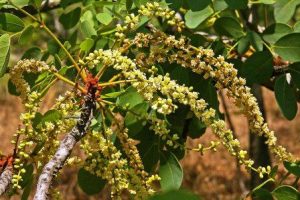
Burkea africana. Photo: Meg Coates Palgrave. Source: Flora of Zimbabwe
At the edge of the ridge there is a folly, a lovely grecian gazebo, there for no reason except to enjoy the view, and also the nearby flame-tree Hymenodyction floribundum, which unfortunately was not in full flame at this time.
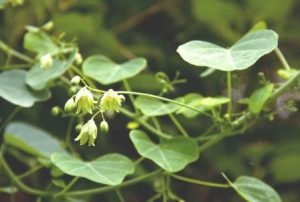
Adenia gumifera. Photo: Bart Wursten. Source: Flora of Zimbabwe
Near the swimming pool, outside the fence, Kim found a Burkea africana, locally called mukarati, the tree with caterpillars – because, when it is covered with them the whole tree would be cut down to get this food source.
I think the heat must have affected me here because I have names but no other details – Garcinia buchanani, Adenia gumifera, Hexalobus sp.
Going down the hill we found a Combretum possibly zeyheri or collinum, but the pods still showed a reddish tinge suggesting collinun. There was some debate as to whether a nearby Commiphora was africana, or mollis or mossambicensis. It was decided, that since the bark was definitely honey-coloured it was mollis. Some of the readers may disagree. It appears that there was a bad bush fire here recently, and the damage caused seem to have affected the bark of many of the trees, making it difficult for identification. But at least they have survived.
We sat for a while near the Bushman paintings. Here, the bushmen are depicted carrying fishing traps. There is a large Sterculia quinqueloba in front of the paintings. Noted for its large leaves, but not a leaf in sight. There was also a Maerua angolensis, renowned for being a source for water. It is not found in Harare. There was a Cassia abbreviata in leaf. One tree puzzled everyone, not in leaf. It had a very distinct curly, flaky bark. Walking to the edge of the ridge we saw, a Kirkia sp. Its berries are a good insecticide. A Cissus cornifolia showed evidence of damage by a porcupine. The Euclea natalensis close by showed evidence of fire damage. I found a chewed-up seed of a mukwa with rodent droppings near it. (maybe that will help the readers who are trying to germinate mukwa seeds). Most of the party had reached the end of the ridge, some were scanning the trees down below, with binoculars. The Trycalysia was also in flowers here.
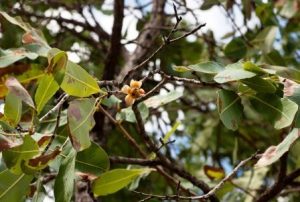
Ochna gambleoides. Photo: Bart Wursten. Source: Flora of Zimbabwe
We took the easy path back up the hill. On our way we found the famous Ochna gambleoides a forlorn looking specimen, with Just three obovota leaves, showing prominent midrib. To me it looked like an up-ended spear left behind by some long-gone impi. By now it was getting hot, so we could only think of a nice cool shady place for lunch. I did notice some Erica sp. on our way.
Each and everyone found them selves a nice shady place somewhere in the garden, or in the shade of the pool house. Some enjoyed a nice cool dip in the pool.
In the afternoon Kim took us around the garden. Too much to relate here, so there will have to be a follow-up.
Our thanks to our hosts Jacqui and Dave Narracott for their wonderful hospitality, in such a beautiful place as Thetford estates.
Perhaps the readers would like to know that Thetford House is now a guest horse offering full accommodation.
-V.Niel
THE TREE SOCIETY ARBORETUM
On the 26th October last we made an afternoon visit to the Arboretum at Lake Chivero.
This place is very important in the annals of the Tree Society. For many years it provided a high percentage of our raison d’etre. Those who went before us did a fantastic job on the steep slopes of Sentinel hill, looking up lake.
I do not intend to dwell here on the history of the arboretum. Mr R.W. Patheram has done this in his usual masterly fashion, published in HERITAGE (the journal of the History Society) issue number 9 of 1989.
We must however dwell on the present and the future, and as a society, we acknowledge. that as the years, decades even, have slipped past, we have held the arboretum less and less high in our order of priorities.
We have been forced to observe the decline before our very eyes; the ram pump broke down; the piping was stolen; David’s Den, the delightful little rustic hut was stolen piece by piece and what we had considered virtually indestructible, the ironstone bench – Doug’s Seat, want the same way. But, and this I stress, the natural environment of the arboretum, solidly set on course by the hard workers in the early days, has thus far survived all the vandalism of our man-made structures.
So to come to what we found on 26th October. The environment was flourishing, good
natural regeneration, both from natives, and introduced indigenous species. But bad damage caused to tree life by the aerial spray used to try and control water hyacinth on the lake. It is difficult to estimate exactly how much of the leaflessness is due to spray and how much is caused by current drought, however, all the twig and die back, and all the twisted and distorted new spring growth is due to this aerial spray pollution.
I could say a lot about the mis-management which caused the need to spray the lake in l99l. I will not do so.
So what of the future? The vegetation of our arboretum will recover, but how many times more will it have to suffer the adverse effects of spray drift before the collectively whole WE of Harare manage to stop the wicked pollution of the vital lake which is our water supply.
On 26th October some or our members saw the arboretum for the first time, others maybe reading these words will likewise learn of the place for the first aims. Have any of you got any ideas. If so please speak to us. Your committee needs all the help it can get.
-George Hall
MATABELELAND NOTES
On, Sunday November 3rd we went 75 Km to Mr w M P Wocd’s farm Glencurragh beyond Nyamandhlovu, an area new to us and full of all sorts of interest. As I have been instructed to deal with the trees alone, I shall not discuss: the steenbok, the kudu. The Gwaai River, the Carmina Bea-eaters, the Dinosaurs, nor the kind hospitality of our hosts, nor the splendid rains that dogged us homewards, nor the Pearly Gates themselves.
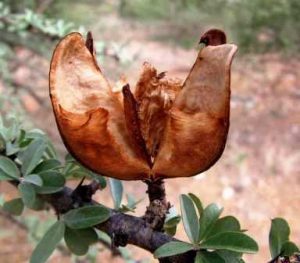
Sesamothamnus lugardii. Photo: Rob Burrett. Source: Flora of Zimbabwe
So to trees, we started out with a special. We were met on entering the farm, and taken to see an unusual tree, which was Sesamothamnus lugardii as evidenced by the nearly 3 cm. corolla spur. The map in “Trees of Southern Africa” only indicates it occurring in the south of this country, but I note that the Rhodesian Botanical Dictionary says that it also occurs in the west. Further, Meg Coates Palgrave was photographing one near Tsashi in May, yet there were flower buds in the West in November. After tea at the farmhouse over looking long areas, mainly Kalahari sand, with frequent pauses, to the Gwaai River, now dry.
On the way in, near Nyamandhlovu, we had seen Diospyros kirkii, the pink one; we then identified some 45 trees, a goodly number for Kalahari Sand. Over a quarter were Acacias, A.ataxacantha, A.erioloba, A.fleckii, A.galpinii A.garrardii, A.karroo, A.mallifera, A.nigrescens, A.nilotica, A.rehmanniana, A.tortilis, A.robusta; also Albizia amara, Baikiaea plurijuga, Bauhinia petersiana, Cassia abbreviate, Colophospermum mopane, Combretum spiculartum, C.collinum with large honey colloured fruits not quite big enough to be C.zeyheri but of good size, C.erythrophyllum, the river Combretum near the Chisa, and the Gwaai, C. imberbe, leadwood, Commiphora schimperi, Groongratissimus, Dichrosstachys cinerea, C.hereroensa, Diospyros lycioides, Euclea undulate, Euphorbia natalensis, Grewia flavescens, Gibortia coleosperma, Kirkia acuminate, Lonchocarpus capassa, Maytenus hererophylla, many, M.senegalensis, one only, Mundules saricea, Paltophorum africanum, small only many, M. senegalensis oneonly, Pterocarpus aangolensis, Rhus lancea, R. pyroides, Ricinodandron rautanenii, Securidaca longopedunculata, Terminalia sericea, Ziziphys,mucronata and a new tree for us in Bulawayo Bosccia salicifolia.
-C. SYKES
THE TOTAL NYAMANDHLOVU EXPERIENCE
You would think that you couldn’t get as better welcome when trees visiting a farm, than to find all the chairs and cups laid out for tea, but you would then be missing out on the main ingredient — an out-of-place Sesamothamnus lugardli – but on our outing to Mike and Trish Hood’s Glencurragh Farm near Nyamandhlovu (75 Km north- west of Bulawayo) we had all that, and more!
Not only because it was in the wrong area, according to the C-P, but this “upside-down” tree always gives us great thrill. Its grotesque yellowish sub-divided trunks covered with spines and smallish leaves are so different from the usual run of trees. We were in time to see the flowers, not quite open – but a long (about 12 cm) dark red corolla with the petals still furled at the end, looking rather like a small knob-kerrie – when opened they are white. The stalk does not join the corolla at the end but on the side, leaving a spur about 1 cm long – like an unbalanced see-saw:
After tea, transport (including Dennis truck) was laid on to take us all on a 20 km trip around the Baikaea wocdland of which this farm mainly consists, and we were rather excited to see about 20 magnificent kudu and one steenbok. At on point we were taken to a huge, burnt and very dead Baikaea plurijuga tree which had been killed by fire about 35 years previously – but is still standing. Most teak trees were still bare, but near a water point there were enough leaves to keep Maureen satisfied. We were making our way to the Gwayi River. On parking, one Carmine Bee-eater was seen which presaged the glorious view of about 400 of them swirling around their nest sites in the river bank which had not been used for about 10 years. The Gwaai, dry of course, was just a sea of sand which Mike informed us was a cap about 4 metres deep on a hard clay foundation — but he manages to pump crystal- clear water from under the sand in great quantities.
On the way back we had a very interesting dissertation on the “umkhawuzana”, botanically Dichapetalum cymosun, a deadly poisonous plant to cattle, which is quite common on Kalahari sand. We were told that one young leaf could kill an ox in half-an-hour, particularly if the beast drinks water or is put under stress – and that this plant is a nightmare to farmers.
During lunch we presented Olea gifts including the new key-ring, which sent Trish off to get a copy of the very appropriate poem, taken From “Verse of T” by Hylda M. Richards :
THE NKOSIKAS’S KEYS
This seemed to be remembered by many in the group as extracts in The Herald had been published in the distant past.
Tales or the super natural followed with a story about a property in the Nyamandhlovu area Mimosa Park which went against African folklore when a previous owner cut down five “lchithamtzi” trees (Lonchocarpus capassa),to build a house. As was forecast, bad luck followed, when the original owner committed suicide; the next happily married couple got divorced, the husband than being trapped against the wall by a run-away truck and getting both legs broken – he then went bankrupt.
The next owners belonged to a way-out religion and lasted a few years until bankruptcy drove them away, to be followed by the tragic triple murder by dissidents of the next owners, and the unfortunate weapon accident of their son, who is still suffering. The present owner commutes from Bulawayo and does not live there. A sad tale, for sure, and the white painted entrance is euphemistically known as The Pearly Gates.
Mike told us of fossil finds on his farm and showed us part of a fossilised bone of a dinosaur, estimated to be about 180 million years old, found at the 40 metre level when a well was being dug.
About two months before our arrival another interesting phenomenon occurred on the farm – the roosting for about 2 weeks of an estimated .5 million queleas Quelea quelea in a patch of dry woodland on the farm. The sheer weight of numbers broke off branches the diameter of a tennis ball from the larger trees, mainly Kirkia acuminata.
On leaving, I idly mentioned a suspension footbridge in the area and Mike took us about 15 Km to the site across the Gwayi River. This specimen is in wonderful condition, about 100 metres across and about 20 metres above the dry river bed. We know of another across the Nyangombi River in the present military area of Nyanga but wonder if any readers have knowledge of any others — besides the Save and Zambezi
Near this Gwayi bridge is an interesting sight – erosion on a grand scale. This is caused by the defloculated clay sodic soils (rich in sodium salts) which form open 6 metre deep “pipes” through the ground which seems to be in constant movement during the rains. When the angle is shallow enough, probably the only invader with any success will be the Colophospermun mopane which has a penchant for this type of inhospitable country side. There are even smooth round indentations where animals have formed salt-licks.
Bad light stopped play on this once-in-a-lifetime outing and with many grateful thanks to Mike and Trish, we left for home, to find a bonus awaiting there, with a real live running river and a full dam – truly a day to remember.
-KEN BLAKE
BOTANIC GARDEN WALK — 5th NOVEMER 1991
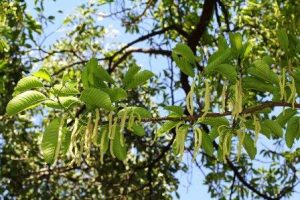
Chlorophora excelsa. Photo: Bart Wursten. Source: Flora of Zimbabwe
This month we looked at the following flowering trees. Chlorophora excelsa, MORACEAE. It was most exciting to see these in flower. The male trees flowered last in 1985 but Kim did not think the female tree had flowered before. These trees and the tree which we failed to find at the Lake MacI1waine arboretum, were grown from Ugandan seed. The male flower spikes are long and thin and carpeted the ground like a mass of worms while the female flower spikes are like fat green caterpillars. The flowers are similar to those of the mulberry and those of Cardiogyne africana, both of which also have separate male and female trees. The seven mvule trees on the banks of the Runde River in Gona re zhou and are being eroded by flood water and are not regenerating.
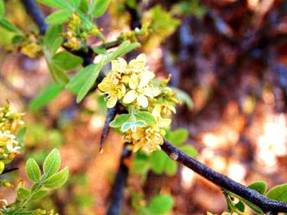
Citropis daweana. Photo: Rob Burrett. Source: Flora of Zimbabwe
Citropis daweana (RUTACEAE) – small yellow flowers, unusual in that the petals occur in fours.
Cordyla africana (PAPILIONDIDEAE) Fluffy heads of orange yellow stamens, petals absent.
Strophanthus kombe (APOCYNACEAE) Attractive flowers with petals extended into streamers. The heart poison, strophanthin extracted from the seeds.
Xylia torreana_ (MIMOSUIDEAE) Fluffy yellow heads. A constituent of the Jesse at Mana Pools.
Gardenia resiniflua (RUBIACEAE) Small white flowers, typical gardenia small.
These five trees are all Zambezi Valley species.
Amblygoncarpus andongensis (MIMOSOIDEAE) Just a Few yellow flower spikes at the top of the tree, looking like Elephantorrhiza spikes. Apparently in both, very small petals are present.
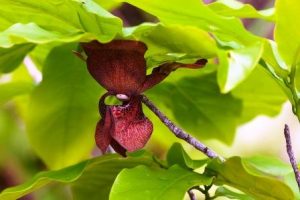
Monodora junodii. Photo: Bart Wursten. Source: Flora of Zimbabwe
Monodora junodii (ANNONACEAE) These liver coloured flowers are always fascinating. The petals are usually thick and leathery in this family and they are supposedly beetle pollinated. In the centre of the flower tightly packed stamens cluster around the knob of the stigma forming one solid mass. The arrangement is identical in the flowers of Annona senagalensis and in those of stenophylla a small plant that we saw in flower recently at Goromonzi.
Cladostemon kirkii (CAPPARACEAE) These Flowers were mostly over and the yellow and white petals had fallen. The androgynophora is a conspicuous tube like projection which branches into stamens and a stigma. This means that they both hang well out of the flower, so presumably it is wind pollinated ?
Erythrophysa transvaalensis (SAPINDACEAE) This has a small compound leaf, with a winged rachis similar to that of Filicium decipiens which is in the same Family. The flowers are pink but it is the inflated, red and green, bladder like pods which are most conspicuous. Occurs primarily in the Transvaal but has also been Found outside Bulawayo.
Thank you Kim,
-Tessa Ball
NAMIBIA TRIP AUGUST 1991 (Continued)
Near Tweefalfontein, (doubtful spring :1) . we camped on a beautiful sand river with Acacia albida and A.erioloba along its length. “There were also two mystery trees. One was a bush with red tube–like flowers and a pea pd. I tried the PAPILIONIDEAE, forgot that the CAESALPINOIDEAE also have pea type pods and resorted to the pictures. It was Adenolobus qaripansis of the Bauhinia family; the butterfly leaf was not very noticeable. The other unknown was a huge tree, that I decided was in the protea family. When that drew a blank I gave up, until I discovered in a book in a tourist shop that it was Euclea pseudebenus. I was also baffled for days by what I think were Salvadora persica and Maerus schinzii.
South of Twaefelfontein, are the most magnificent rock engravings, over 2000 of them on huge rock slabs which litter the mountain side. There are hunman footprints, game spoor, elephant, ostrich, rhino, giraffe etc., all pale rigures carved in the red surfaces. Amongst the rocks were the Brandbarg acacias, A.montis-usti (literally meaning burnt mountains). Their copper bronze bark, was beautiful against red rock and blue sky.
And so to Swakapond, where we took a fabulous beacon—marked drive through the desert. The first stop is at the lichen fields. There are yellow, orange and red lichens growing on the pebbles but most are a gray-black and when blown into the dips in the sand, they look just like decaying vegetation. We tried pouring water on some but it didn’t seem to make much difference. I picked up two samples but1hen read that lichens grow about 1 millimetre a year, realizing with horror that I was holding 50 years worth of growth promptly Put them out at the next stop. The Swakop River has worn a moonscape or badlands landscape where it has eroded the tableland and one looks across this at Rossing Mountain (Rossing Uranium). Down at the bottom of the canyon is Croanikontss oasis where we saw tamarisks and mesquites. At one point the old wagon route from the sea to the interior crosses the present road. Although it is 100 years since it was last used the lichens have not completely regenerated and the surface is a different colour to that on either side.
Finally the welwitschias. We drove past hundreds and hundreds on either side of the road along the last few kilometres of the drive. But in this area at least they are not wide spread, occurring only along the drainage lines, in a couple of valleys. The great—,granddaddy of them all, estimated at being 1500 years old, was fenced off in its own enclosure with a viewing platform built alongside. Apparently walking around them compacts the sand and is hence detrimental to air movements beneath the surface which are vital for moisture procurement. The lichens and most of the plants exist solely became of the sea mists which can roll inland for up to 60 kms. I don’t know if the welwitschias with their large tap roots are drawing an underground water as well. Male and female plants were easily recognizable by their different cones; the male cones being dark red brown and the female cones larger and pale yellow.
At one of our stops we investigated the only two shrubby trees in sight, in all the miles of sand. They had both been devastatingly browsed and it was amazing to see them circled by a mass of game tracks and spoor, in the middle of the desert. One was an Acacia albida and the other Parkinsonea africana, with not a leaflet on it. A couple of pods and flowers, large, yellow and striking served to identify it.
We went to Walvis Bay one evening to see the Flamingos (tiresome border control formalities as this is now R.S.A. territory). This was a fantastic sight, with the Greater and the Lesser circling and feeding in the shallow water, though an icy wind kept us in the vehicles. We drove around the salt works where sea water is left to evaporate in huge pans, and the salt layer harvested once a year. Cold wind or no, we couldn’t resist nipping out to pick up huge lumps of salt – not good news for the underside of the truck.
South of Walvis Bay, we moved inland through the most fantastic scenery of the trip, across the Kuiseb Canyon and through mountains and sand of every shade of colour. Here is the aptly named Solitaire – just one house and one petrol station. We camped at Sesriam, in the Namib/Nairkluft Park which stretches all the way from Swakopomd to Luderitz. The Sesreim River which flows occasionally, loses itself in Sossusvlei and just an acacia filled depression amid the dunes. We explored the Sesrien Canyon. (so named because the people originally lifted water from it with six riens) and it actually had water in it. There were many desert plants, some in flower, along the floor of the canyon. The famous red sand dunes of this area are star shaped, absolutely huge (up to 1000 foot high) and have knife-like ridges off which the fine sand blows continuously. It was reminiscent of the snow blowing off the ridges of Everest. The postcards of blue sky, red sand dune, camel thorn and gemsbok look unbelievable until you’ve seen it. As we battled up Dune 45 we watched beetles and a geko skitter over the surface at a great rate. At night there was an inquisitive bat-eared fox visiting the camp sites, who would stand and look at us in the torch light only metres away.
Then on to Ludsritz. what do the wild horses in that desert plain find to eat, many of the herd we saw appeared to be lame. Here the sand dunes are small and crescent shaped. The white sand drifts across the road sometimes obliterating most of the tar and the fiendish wind made driving hazardous.
Our route back was via Upington with its vineyards, Augrabies Falls and the excitement of realizing that the Fig I was battling to identify was the very tree shown on Page 106 in Coates Palgrave – Ficus cordata; Kurunan, where the Eye of Kurunan still flows strong and clear, and the water is channelled the 5 kms to Mary Moffat’s garden and past the original church; and Tschipise with its magnificent trees – vast schotias and nyala berries such as we saw at Tuli. The cherry on the top was discovering Alchornea laxiflora; new to me; in a five minute, road side stop south of Masvingo. what a trip!
-TessaBall
KIM DAMSTRA CHAIRMAN


